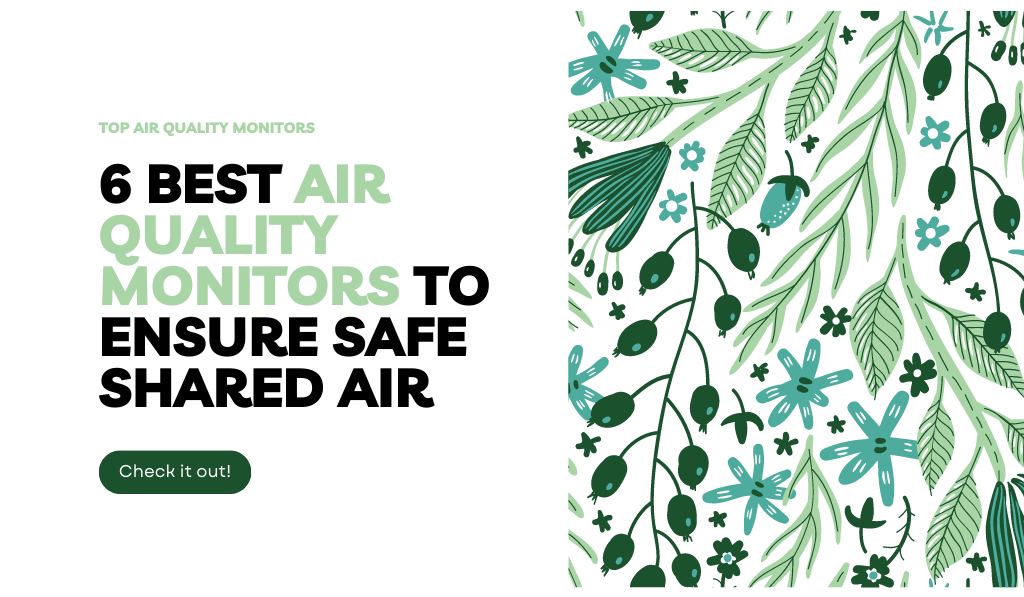6 Best Air Quality Monitors to Ensure Safe Shared Air
Category: Top Products

TIER10 AUTHOR
February 23, 2023

Disclosure: Our website contains affiliate links. This means that if you make a purchase through these links, we may receive a commission or other compensation.
Category: Top Products

February 23, 2023

Last Update
1 year ago

Despite the fact that we spend 90% of our time indoors, you may not have given much thought to indoor air quality until recently. If you are concerned about the air quality in your home due to the global pandemic and widespread smoke from devastating wildfires, you should consider purchasing an air quality monitor.
An air quality monitor monitors the ventilation quality in a room and provides measurements of pollutants such as carbon monoxide, carbon dioxide, volatile organic compounds, fine particles, and others. One of the most significant advantages of air quality monitors is their ability to measure CO2. CO2 measurements, which can be determined with most air quality monitors, can give an idea of how much of the air you are inhaling comes from other people’s respiratory systems.
Indoor air quality has a significant impact on people’s health and well-being. According to The New York Times, buildings in the United States have become better sealed in the last 50 years, which helps with heating and cooling but also makes it easier for trapped gases and chemicals to enter. Poor indoor air quality and inadequate ventilation have been shown to dull cognitive abilities and even cause chest pains, headaches, and eye, nose, and throat irritation.
If an air quality monitor gives you a low air quality rating, the first step to improving indoor air quality is to increase ventilation of your indoor space by allowing fresh air in from outside or by running an air purifier. Increased ventilation, according to the EPA, helps remove or dilute indoor airborne pollutants and can help protect you against COVID-19.
Another tip for maintaining good air quality is to keep your home clean in order to reduce the accumulation of dust, mold, and pet dander. According to the Asthma and Allergy Foundation of America, dust mites and pet dander thrive in furniture, carpets, and bedding, so in addition to vacuuming, you should wash your sheets once a week.
A potent but user-friendly tool, the uHoo air quality monitor, monitors nine key factors. It examines the following parameters: air pressure, temperature, humidity, TVBOC (total volatile organic compounds), carbon dioxide, PM2.5, carbon monoxide, and nitrogen dioxide.
One of the top air quality sensors that TechHive evaluated, according to contributor Alec Wagner, was the uHoo Smart Air Meter. They claimed that “The Uhoo performs a fantastic job of giving actionable notifications about increasing your air quality.” It has a high price tag but offers sensitive and precise pollution detection. The device, which resembles a coffee thermos in size, links to your Wi-Fi network so you can monitor the air quality in your house. The monitor can warn you when measurements exceed the thresholds you’ve set with the use of a handy app, and it will even provide advice on how to improve your air quality. It also provides users with a virus index tool that analyzes air quality data to provide you useful information about the likelihood of a virus surviving in your surroundings.
You may place the Airthings Wave Plus on your walls or ceilings, and it has a smoke detector-like appearance. This one doesn’t require plugging into an outlet because it is powered by AA batteries. The Wave Plus air quality meter stands out from its rivals thanks to its capacity to detect radon. In case you’re not familiar, one of the main causes of lung cancer is radon, a radioactive gas.
The instrument measures temperature, humidity, VOCs, air pressure, and carbon dioxide in addition to radon. The gadget syncs with your phone or tablet so you can monitor data, understand the meaning of each measurement, and figure out how to raise levels. If the quality of your air declines, a glowing ring on its face changes from green to yellow to red.
The SAF Aranet4 is a wireless indoor air quality monitor that runs entirely on batteries. It continuously measures temperature, relative humidity, atmospheric pressure, and carbon dioxide levels. The latter can provide a ton of important information for lowering your risk of COVID-19 exposure.
The World Health Organization advises that indoor CO2 concentrations never exceed 1,000 ppm and should instead range between 500 and 700 ppm. When CO2 levels are too high, this sensor will buzz and alert you.
AA batteries that can run the monitor for several years on a single charge are used. Also, it connects to your smartphone so you may examine and analyze up to two weeks’ worth of recorded data.
The Temtop M10 is a simple, quick-to-install, and space-efficient air quality monitor. The device scans the air for VOCs, small particles, and formaldehyde using a mix of lasers and algorithms.
We enjoy that a rechargeable battery power it. You won’t need to change the AA batteries or keep it close to an outlet that way.
A warning will ring if the gadget detects an excess of harsh chemicals, alerting you to boost airflow by opening windows or turning up the power of your air purifier. The device is simple to use because to its one button, and since it is battery-powered, you can take it with you everywhere you go.
Awair, which has a smart name, provides you with a real-time picture of the air quality in your house and lets you track data over time using a simple, free app. We love how sleek and contemporary it looks, and how well it would fit in any space in your house.
The device looks fantastic and works hard to monitor the air in your environment for temperature, humidity, carbon dioxide, volatile organic compounds, and particle matter. On its front LED panel, numerical levels for each of these categories can be shown, together with a score (on a scale of 100) that accounts for each level.
One of the few air quality monitors with Apple HomeKit support currently available is The Eve Room. Apple’s HomeKit system for managing your smart home gear is comparable to Amazon Alexa and the Google Assistant, but it differs from the other two in that you can operate all of your smart home gear from a single app rather than needing different apps for each smart home item. Also, manufacturers are required to adhere to Apple’s stricter security and privacy standards, making it both safer and much easier to use and set up.
The system can keep an eye on TVOCs, humidity, and temperature. On your Apple smartphone or tablet, you can sort and categorize the data it gathers by hours, days, weeks, months, and years.The device also assigns a 5-star rating to your air. You can choose which measurements you want to remain readily visible by adjusting an arrow on its display. The rechargeable Eve Room has a battery life of about six weeks on a single charge.
Air quality is an important factor to consider when it comes to the safety of our shared air. With the right air quality monitors, you can ensure that your indoor air is safe and healthy for everyone. In conclusion, we have discussed 6 of the best air quality monitors on the market today. We looked at their features, and how they can help you keep your indoor air clean and safe. Here are some of high quality and affordable Air Quality Monitor you might considering buying.
Top Tier 10 Products is in Partner with Involve, that is designed to provide a means for sites to earn advertising fees by advertising and linking to shops. All product names, logos, and brands are property of their respective owners. All company, product, and service names used on this website are for identification purposes only.
The information provided on this website is for general informational purposes only. We make no representations or warranties of any kind, express or implied, about the completeness, accuracy, reliability, suitability, or availability of the information contained on the website for any purpose. Any reliance you place on such information is therefore strictly at your own risk.
Copyright © 2022-2023 Top-tier Products. All Rights Reserved.